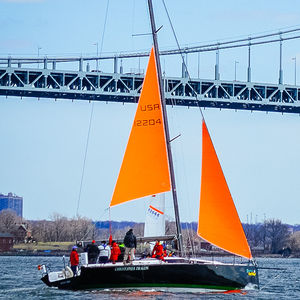
- Sailing
- Sailing Equipment and Gear
- Storm jib
- UK-Halsey International
Storm jib for cruising sailboatspolyester
Add to favorites
Compare this product
Characteristics
- Type
- storm jib
- Applications
- for cruising sailboats
- Material
- polyester
Description
The Storm Jib is used in winds too strong for heavy weather jibs like No. 3 and No. 4 genoas. The ISAF Offshore Special Regulations limits the storm jib’s area to five percent of the height of the foretriangle squared. The rule states that the luff of the storm jib must be shorter than 65% of the height of the foretriangle. It has a hollow leech and hollow foot to prevent the edges from fluttering and it is designed to fly from a pennant to keep the sail above breaking waves. The storm jib must be made out of strong woven polyester and it is required that the color be highly visible. This picture shows how well Storm Orange sails stand out in dark skies.
If the storm jib is made to fit a luff-groove device, the sail must have an alternative means of being attached to the stay. The most common alternative method is to have grommets along the luff so that you can tie the sail to the stay as shown below.
The most common alternate luff attachment is to tie around the headstay. The ties have to be permanently attached to the sail.
Sailing in 40 knots of wind with the storm jib and two reefs.
Catalogs
No catalogs are available for this product.
See all of UK-Halsey International‘s catalogs*Prices are pre-tax. They exclude delivery charges and customs duties and do not include additional charges for installation or activation options. Prices are indicative only and may vary by country, with changes to the cost of raw materials and exchange rates.



